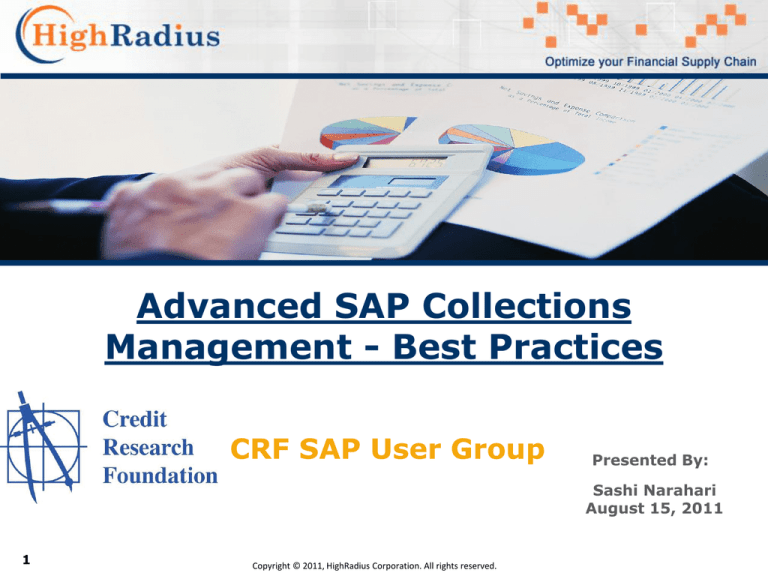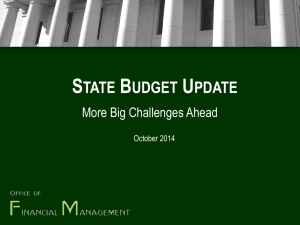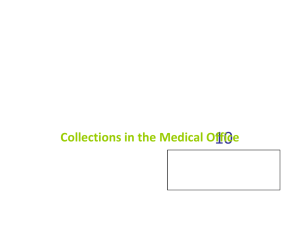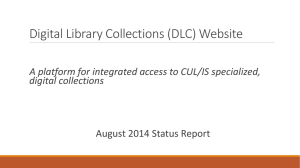
Advanced SAP Collections
Management - Best Practices
CRF SAP User Group
Presented By:
Sashi Narahari
August 15, 2011
1
Copyright © 2011, HighRadius Corporation. All rights reserved.
Agenda
• FSCM Overview
• Collection Management Overview
• Collections Best Practices
2
FSCM Modules At-A-Glance
3
Receivables
Management
4
SAP FSCM Collections Management
Overview
5
SAP Collections Management
Overview
Collection Supervisor
Define collection strategies /
rules
Define work item assignment
to users / groups
Monitor and reallocation of
workload
6
Collection Specialist
Incoming / Outbound collection
calls
Process daily worklist based on
prioritization
Record customer contact and
follow up
Collections Management: Collection
Specialist
7
Collections Management: Collector’s Worklist
Text
Double-Click to open
customer work item
8
Collections Management: Invoice Summary
Text
Default Customer
Contact readily
available
Review open items to
be collected
9
Collections Management: Payment History
Review payment
history
10
Text
Collections Management: Dispute Cases
Review open and
closed dispute cases
11
Text
Collections Management: Promise-to-Pay
Text
Record promise for
payment or customer
contact at the invoice
level
12
Collections Management: Promise-to-Pay
Promise for payment has
been recorded
13
Text
Collections Management: Customer Contact
Text
Record customer contact
resulting in completion
of the work item
14
Collections Management: Completed Item
Work item
completed
15
Text
Collections Management: Resubmission
Create a Follow-up
reminder on
specific invoices
Collections Management: Resubmission
Summary of all
Follow-Ups
Collections Management: Notes
Select invoice and
enter invoice
specific notes
Collections Management: Notes
Summary of all
Notes
Collections Management: Correspondence
Several
Correspondence
Options available
Collections Management: Correspondence
Email contact
notes and log
directly from SAP
to customer
Collections Management: Correspondence
Select the specific
type of
correspondence or
letter to send
Select a set of
invoices
Collections Management: Collection
Manager
23
Data available for Collection Strategies
• Broken Promise to
Pay
• Number of Promise
to Pays
• Promise to Pay
Amount
• Customer Contacts
• Resubmissions
• Master Data or
Operational Data
which can be added
to collections
management
24
Collections
Data
Open AR &
Dispute
Mgmt Data
Other Data
Credit Data
•
•
•
•
•
•
•
Aging
Amount
Dunning Level
Amount Dunned
Disputed Amount
Dispute Case Status
Payment Data
•
•
•
•
Credit Limit
% Utilization
Credit Exposure
Risk Category
Collections Strategy Definition
Collection
Strategy
Collection
Rules
Basic
Rules
High to Medium Risk and
greater than 80% Credit
Limit Utilization
Risk Category
Valuation: 15 points
Credit Limit Utilization
Dunning Level
Collection Strategy for
Higher Risk Customers
Past Due Invoices Over 15
days Past Due & Dunned
One or More Times
Documents by posting key
and document type
Valuation: 20 points
Individual Items Overdue
Since N Days
Resubmission Due for the
Customer
Valuation: 5 points
25
Resubmission Due for the
Customer
Collections Management: Collection Strategy
Text
Collection Rules
within the Collection
Strategy
26
Collections Management: Collection Strategy
Text
Conditions within a
Collection Rule
27
Collections Management: Collection Strategy
Text
Automatic
Prioritization of
Customer Work Items
28
Collections Management: Collection Strategy
Text
Priority is determined by
the valuation of each
collection rule
29
Collections Best Practices
30
Collections Best Practices
Customer Segmentation
Automated Correspondence
‘Invoice-Level’ Collections
Collect on ‘Clean Receivables’
Blocked Order Based Collections
31
Customer Segmentation
• By Size
– Large Accounts
– Small & Medium Businesses (SMB)
• By Payment Behavior (Days Beyond Terms)
– Fast Pay, Medium Pay, Slow Pay
• By Risk Category
– High, Medium, Low
• Sales Volume
– High, Medium, Low
32
Automated Correspondence
for SMB
• Gentle Reminders, Past-Due Notices, Demand
Letters (Standard SAP A/R Dunning)
– For most SMB Customers
– Except for ‘Fast Pay’ or ‘High Sales Volume’
• Include Invoice Copies, POD Copies for 2nd
and/or 3rd level Dunning (Requires
Enhancements to FSCM)
33
Slow or Med Pay SMB
Collection Strategy
34
Advanced Correspondence
35
Advanced Correspondence Automation
Selection criteria: type of
letter, attachments and
method of communication
36
Advanced Correspondence Automation
Highlight AR line
items to be included
in correspondence
37
Advanced Correspondence Automation
Cover Letter
38
Advanced Correspondence Automation
Invoice Attachments
39
Advanced Correspondence Automation
POD Attachment #1
40
Advanced Correspondence Automation
POD’s attached to the
Invoice AR line item
41
Invoice-Level Collections
• Dunning might not work for Large Customers
• Most large business have automated AP
systems and are not paying because there is a
‘issue’ with the invoice
• Invoice-Level Collections similar to Disputes
• First perform root cause analysis based on
history what the reasons for ‘issues’ are
– EDI Transmissions, Disputes (Pricing Errors,
Shortages etc)
• Create ‘Dispute Case’ for ‘problem invoices’
42
Create Disputes for Invoices
43
‘Clean’ Receivables
To Be Collected Amount Calculation
Total
Amount
Past Due
44
Items with
Open
Promise to
Pay
Dispute
Cases not in
a ‘To Be
Collected’
Status
Items with
a Current
Dunning
Notice
Items
Arranged
for Payment
Amount ‘To
Be
Collected’
Total Amount Past Due – Total of all overdue items in FI-Accounts Receivable
Items with Open Promise to Pay – If there items with an open promise to pay, or items with
a future payment promised on date, these items will be excluded from the ‘To Be Collected’
amount
Dispute Cases not in a ‘To Be Collected’ Status – All open dispute cases, which have not
been updated with a status that is mapped to the ‘To Be Collected’ in collections
management, will be excluded from the ‘To Be Collected’ amount
Items with a Current Dunning Notice – If a line item in FI-Accounts Receivable has recently
been dunned, this amount will be excluded from the ‘To Be Collected’ amount.
Items Arranged for Payment – All amounts that are (a) collected with a debit memo
procedure or (b) where the account statement balance contains a payment notification from
the bank will be excluded from the ‘To Be Collected’ amount
BAdI: Amount To Be Collected: Can be used to enhance the to be collected amount
calculation
Use ‘Collectable Amount’ in
Strategies
45
http://www.highradius.com









